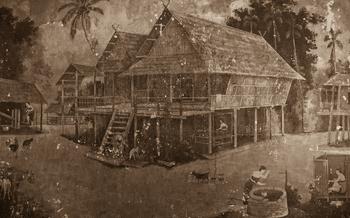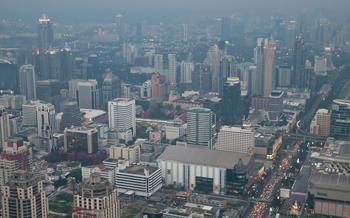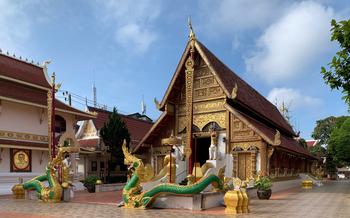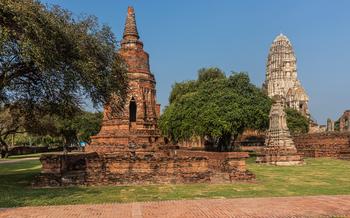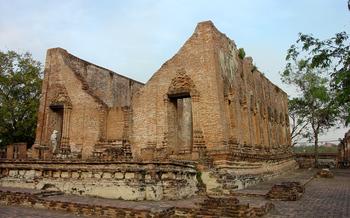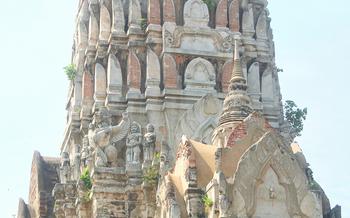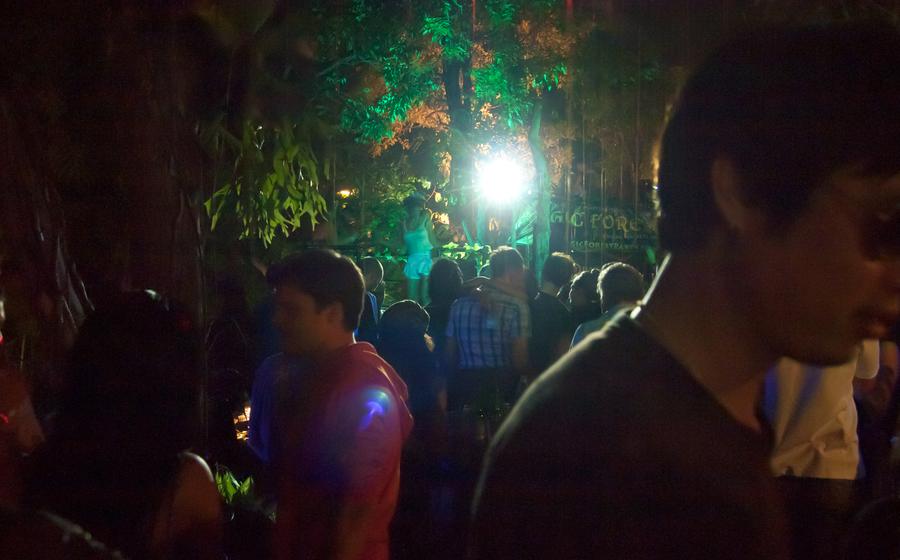
Wat U Mong Mahathera Chan
- The Wat U Mong Mahathera Chan: A Spiritual Haven
- Exploring the Temple Grounds
- The Serene Buddha Images
- The Sacred Relics: A Glimpse into History
- The Majestic Stupas: Symbols of Enlightenment
- The Dhamma Hall: A Place of Learning
- The Meditation Center: A Sanctuary for Inner Peace
- The Temple Museum: A Journey through History
- The Temple's Gardens: A Tranquil Oasis
- The Temple's Festivals and Celebrations
- The Temple's Community Outreach: A Force for Good
- Insider Tip: Unveiling the Hidden Gem
The Wat U Mong Mahathera Chan: A Spiritual Haven
Nestled amidst the serene landscapes of Chiang Mai, Thailand, lies a sacred sanctuary that beckons spiritual seekers and culture enthusiasts alike – the Wat U Mong Mahathera Chan. This magnificent temple, also known as the "Forest Monastery," is an oasis of peace and tranquility, inviting visitors to embark on a journey of self-discovery and spiritual enlightenment.
The Wat U Mong Mahathera Chan was founded in 1962 by Venerable Boonmee Methangkuro, a highly esteemed Buddhist monk and meditation master. Inspired by his deep connection with nature, Venerable Boonmee envisioned a temple that would serve as a retreat for monks and laypeople to immerse themselves in meditation and embrace the teachings of the Buddha.
Located on the outskirts of Chiang Mai, the temple is easily accessible by public transportation or private vehicles. Surrounded by lush greenery and tranquil surroundings, the Wat U Mong Mahathera Chan exudes an aura of serenity, setting the stage for a profound spiritual experience.
As visitors step into the temple grounds, they are greeted by a symphony of architectural wonders. The temple complex showcases a harmonious blend of traditional Lanna and modern styles, reflecting the rich cultural heritage of northern Thailand. Intricate carvings, colorful murals, and towering spires adorn the temple buildings, creating a visually stunning spectacle that captivates the senses.
Exploring the Temple Grounds
A visit to Wat U Mong Mahathera Chan reveals a sprawling and intricate complex, rich in symbolism and architectural beauty. A map of the temple grounds guides visitors through the various structures and highlights, ensuring they don't miss any of the temple's treasures.
The main structures within the temple include the ubosot, the viharn, and the chedis. The ubosot, or ordination hall, is the most sacred building in the temple, where important ceremonies and rituals take place. The viharn, or assembly hall, is where monks gather for daily prayers and meditation. The chedis, or stupas, are monumental structures that symbolize the Buddha's teachings and enlightenment.
Notable features of the temple include the exquisite murals that adorn the walls of the ubosot, depicting scenes from the Buddha's life and teachings. The chedis are also adorned with intricate carvings and sculptures, showcasing the artistry and craftsmanship of the temple's builders.
Visitors can choose to explore the temple grounds on their own or opt for a guided tour. Guided tours provide in-depth insights into the temple's history, architecture, and significance, enhancing the visitor's understanding and appreciation of this sacred space.
The Serene Buddha Images
The Wat U Mong Mahathera Chan is home to a diverse collection of Buddha images, each possessing its own unique characteristics and symbolism. These revered representations of the enlightened one come in various sizes, postures, and styles, reflecting the rich artistic traditions of Thailand.
Among the most notable Buddha images in the temple is a colossal golden Buddha statue enshrined in the main ubosot. Standing tall and radiating an aura of serenity, this majestic figure commands attention and inspires awe. The intricate details of the statue's features, from the gentle smile to the intricate robes, showcase the exceptional craftsmanship of Thai artisans.
In addition to the grand golden Buddha, the temple also houses a collection of smaller Buddha images scattered throughout the complex. These images vary in size, from miniature statues to life-sized figures, and depict different postures and mudras (hand gestures). Some of the most common postures include the seated Buddha, the standing Buddha, and the reclining Buddha, each conveying a specific symbolic meaning.
For example, the seated Buddha represents the state of meditation and inner peace, while the standing Buddha symbolizes the Buddha's unwavering determination and resolve. The reclining Buddha, on the other hand, signifies the Buddha's final moments on earth and his entry into parinirvana, the ultimate state of liberation.
The Buddha images in the Wat U Mong Mahathera Chan are not merely works of art but are also objects of deep veneration and devotion. Visitors often pay homage to the Buddha images by offering flowers, incense, or candles as a way of showing their respect and gratitude. The act of paying homage is believed to bring merit and blessings to the devotees, strengthening their connection to the teachings of the Buddha.
The Sacred Relics: A Glimpse into History
Wat U Mong Mahathera Chan is home to a collection of sacred relics that hold immense significance and veneration in Buddhism. These relics are believed to be remnants or objects associated with the life of Buddha or other revered figures in Buddhist history. The presence of these sacred relics elevates the temple's status and attracts pilgrims and devotees from far and wide.
The relics enshrined at the temple vary in nature and form. They can include bone fragments, teeth, hair, or personal belongings of the Buddha. Some relics may be encased in elaborate reliquaries or stupas, adorned with precious stones and intricate designs. Others may be displayed in a simple yet respectful manner, allowing visitors to connect with the tangible history of Buddhism.
The veneration of sacred relics in Buddhism is rooted in the belief that they possess a powerful spiritual energy or blessing. Devotees offer prayers, make offerings, and perform rituals in front of the relics as a way of paying homage to the Buddha and seeking merit or blessings. The presence of these relics creates a sense of sacredness and awe, inspiring visitors to reflect on the life and teachings of the Buddha.
The historical context and origins of the relics enshrined at Wat U Mong Mahathera Chan are often shrouded in mystery and legend. Some relics are believed to have been passed down through generations, while others may have been discovered through archaeological excavations or donations. Regardless of their origins, these relics are considered precious and invaluable, serving as tangible links to the history and legacy of Buddhism.
Rituals and ceremonies associated with the sacred relics are an integral part of the temple's religious practices. These rituals may include chanting, meditation, offering of flowers and candles, and the circumambulation of the reliquaries. Devotees often make pilgrimages to the temple specifically to pay homage to the relics, seeking spiritual guidance, protection, or blessings. The presence of these sacred relics adds a profound dimension to the temple's atmosphere, making it a place of deep reverence and devotion.
The Majestic Stupas: Symbols of Enlightenment
The Wat U Mong Mahathera Chan boasts several majestic stupas, which are iconic structures in Buddhist architecture. These stupas, also known as chedis, hold profound symbolism and significance in the Buddhist tradition.
The stupas at the temple vary in size and design, each representing different aspects of the Buddha's teachings and embodying the path to enlightenment. The largest and most prominent stupa is the Phra That Chom Thong, which stands tall as a symbol of the Buddha's victory over Mara, the tempter. The stupa's golden spire reaches towards the heavens, representing the Buddha's attainment of enlightenment and his liberation from earthly desires.
Other stupas within the temple complex include the Phra That Sihing, which enshrines a replica of the revered Phra Sihing Buddha image, and the Phra That Ku, which is believed to contain relics of the Buddha. Each stupa is adorned with intricate carvings and decorative elements, showcasing the temple's artistic and cultural heritage.
In Buddhism, stupas serve as objects of veneration and meditation. Devotees often circumambulate the stupas, offering prayers and making offerings of flowers, incense, and candles. The act of circumambulation represents the circumambulation of Mount Meru, the sacred mountain at the center of the Buddhist universe.
The stupas at Wat U Mong Mahathera Chan are not merely architectural marvels but also powerful symbols of enlightenment and spiritual liberation. They invite visitors to contemplate the Buddha's teachings, reflect on the nature of existence, and embark on their own journey towards inner peace and wisdom.
The Dhamma Hall: A Place of Learning
Within the temple grounds, the dhamma hall stands as a sanctuary for learning and spiritual development. This spacious hall is designed to accommodate teachings, lectures, and meditation sessions, fostering a conducive environment for the exploration of Buddhist principles and practices.
The dhamma hall exudes an aura of tranquility, with its simple yet elegant interiors. Rows of meditation mats are carefully arranged, inviting visitors to settle into a comfortable position and immerse themselves in the teachings. The hall's design promotes a sense of equality and inclusivity, as everyone can participate in the sessions regardless of their background or level of experience.
Notable teachers and monks, renowned for their wisdom and compassion, often grace the dhamma hall to share their insights and guidance. Their teachings cover a wide range of topics, from the fundamentals of Buddhism to advanced meditation techniques. These sessions provide a valuable opportunity for visitors to deepen their understanding of the dharma and cultivate a deeper connection with their spiritual journey.
When attending a dhamma hall session, it is important to observe proper etiquette and customs to maintain a respectful and harmonious atmosphere. This includes arriving on time, removing one's shoes before entering the hall, and maintaining silence and mindfulness throughout the session. Visitors are encouraged to actively participate in the teachings and ask questions if they have any doubts or clarifications.
The dhamma hall at Wat U Mong Mahathera Chan serves as a sanctuary for those seeking to expand their knowledge of Buddhism and enhance their spiritual practice. Whether you are a seasoned practitioner or a curious newcomer, the teachings and guidance offered in this sacred space can provide profound insights and inspiration on your journey towards enlightenment.
The Meditation Center: A Sanctuary for Inner Peace
Nestled within the serene grounds of Wat U Mong Mahathera Chan lies a sanctuary for inner peace and tranquility—the meditation center. Here, visitors have the opportunity to delve into the profound teachings of Buddhism and embark on a journey of self-discovery through various meditation practices.
The meditation center offers a range of meditation techniques, catering to different levels of experience and preferences. Whether you are a seasoned practitioner or a complete beginner, you will find guidance and support to deepen your meditation practice. The experienced monks and teachers at the temple are always willing to share their knowledge and provide personalized instruction.
The center provides a serene and conducive environment for meditation, with dedicated spaces designed to facilitate inner peace and focus. Cushions, mats, and other meditation aids are available for your comfort. You can choose to meditate in a group or find a quiet corner for solitary contemplation.
The meditation center also offers retreats, workshops, and courses for those seeking a more immersive experience. These programs provide in-depth teachings on meditation techniques, Buddhist philosophy, and mindfulness practices. Whether you are looking to enhance your existing practice or learn meditation for the first time, these programs offer a comprehensive and transformative experience.
Through meditation, visitors to Wat U Mong Mahathera Chan can find a sanctuary for inner peace, reduce stress, develop mindfulness, and cultivate a deeper connection with themselves and the world around them. It is a unique opportunity to explore the transformative power of meditation in a sacred and serene environment.
The Temple Museum: A Journey through History
Nestled within the serene grounds of Wat U Mong Mahathera Chan lies a treasure trove of Buddhist history and heritage—the temple museum. This repository of knowledge houses a captivating collection of artifacts, relics, and exhibits that chronicle the rich history of Buddhism in Thailand and beyond.
As you step into the museum, you are greeted by an array of ancient Buddha images, each exuding a unique charm and story. The intricate carvings and delicate features of these statues showcase the artistry and devotion of past craftsmen. Among the highlights is a rare and exquisite golden Buddha image that radiates an aura of divinity.
The museum also features a collection of ancient manuscripts and scriptures, some of which are centuries old. These precious texts provide a glimpse into the teachings and practices of Buddhism from its early days. Visitors can marvel at the intricate calligraphy and the wisdom contained within these sacred texts.
Additionally, the museum showcases various artifacts related to Buddhist rituals and ceremonies. From ornate incense burners and ceremonial robes to musical instruments used in temple rituals, these objects offer a fascinating insight into the rich traditions of Buddhist worship.
The temple museum serves as a living testament to the enduring legacy of Buddhism in Thailand. Through its exhibits and artifacts, visitors can embark on a journey through time and gain a deeper understanding of the religion's profound impact on Thai culture and society.
The Temple's Gardens: A Tranquil Oasis
Amidst the grandeur of the temples and stupas, the Wat U Mong Mahathera Chan boasts a stunning array of gardens that serve as a tranquil oasis for visitors seeking peace and serenity. Expertly landscaped with a diverse collection of plants, flowers, and water features, the gardens create a harmonious blend of natural beauty and spiritual significance.
Strolling through the gardens, visitors are greeted by an explosion of colors and fragrances. Vibrant blooms of orchids, lilies, and jasmine fill the air with their sweet scent, while lush greenery provides a sense of tranquility. The gardens are meticulously maintained by the monks, who carefully tend to each plant, ensuring its flourishing growth.
Beyond their aesthetic appeal, the gardens hold deep symbolic meaning in Buddhism. The lotus flower, in particular, is a prominent feature, representing purity and spiritual enlightenment. Its ability to rise from murky waters and bloom into a beautiful flower symbolizes the potential for transformation and the journey towards enlightenment.
The gardens also serve as a place for meditation and contemplation. Visitors can find secluded spots beneath the shade of trees or beside tranquil ponds, where they can sit in silence, focus on their breath, and let go of distractions. The peaceful atmosphere and natural surroundings create an ideal environment for cultivating inner peace and clarity.
As the sun begins to set, the gardens take on a magical aura. The golden hues of twilight cast a warm glow on the flowers and foliage, creating a picturesque scene that is both enchanting and serene. Visitors can take this opportunity to capture stunning photographs or simply sit and appreciate the beauty of nature's transition.
The temple's gardens are not merely ornamental; they are an integral part of the temple's spiritual landscape. They offer a sanctuary for visitors to escape the hustle and bustle of everyday life, find solace in nature, and connect with the deeper meaning of existence.
The Temple's Festivals and Celebrations
The Wat U Mong Mahathera Chan comes alive during its annual festivals and celebrations, offering visitors a glimpse into the vibrant cultural and religious traditions of Thailand. The most significant festival is Visakha Bucha, which commemorates the birth, enlightenment, and passing of Gautama Buddha. During this festival, the temple is adorned with colorful decorations, and special ceremonies, chanting, and processions take place throughout the day.
Another important festival is Songkran, the Thai New Year, which is celebrated in April. During Songkran, the temple becomes a hive of activity as locals and visitors alike participate in water-throwing ceremonies, symbolizing the washing away of sins and bad luck.
Loy Krathong and Yi Peng are two festivals that showcase the temple's beautiful grounds. During Loy Krathong, people release decorated floating kratongs (lotus-shaped boats) into the water to pay respect to the water spirits. During Yi Peng, the sky is illuminated with thousands of floating lanterns, creating a magical and ethereal atmosphere.
Visitors planning their trip to coincide with one of the temple's festivals will be rewarded with a truly immersive and unforgettable experience.
The Temple's Community Outreach: A Force for Good
The Wat U Mong Mahathera Chan is not only a spiritual sanctuary but also an active participant in community outreach and social welfare initiatives. The temple's monks and volunteers are deeply committed to giving back to the community and making a positive impact on the lives of those in need.
The temple runs various social and community projects that address a range of issues, including education, healthcare, and social welfare. The temple's monks and volunteers provide support and assistance to underprivileged families, the elderly, and those facing hardships. They organize food distribution programs, medical check-ups, and counseling services to help those in need.
The temple also plays a vital role in promoting education and learning. It runs a school that provides free education to children from the surrounding villages. The school offers a comprehensive curriculum that includes both academic subjects and Buddhist teachings. The temple also organizes workshops, seminars, and training programs for the local community, covering topics such as vocational skills, financial literacy, and personal development.
Visitors to the temple are welcome to participate in the temple's community outreach programs. Volunteer opportunities are available for those who wish to contribute their time and skills to help the temple's initiatives. Visitors can also make donations to support the temple's community outreach work.
By actively engaging in community outreach, the Wat U Mong Mahathera Chan exemplifies the Buddhist teachings of compassion, generosity, and service to others. The temple's community outreach programs not only provide practical support to those in need but also foster a sense of community and unity among the temple's devotees and the surrounding community.
Insider Tip: Unveiling the Hidden Gem
Beyond the main attractions, Wat U Mong Mahathera Chan holds a hidden gem that few visitors know about. Tucked away in a secluded corner of the temple grounds is a small meditation cave. This tranquil sanctuary is adorned with intricate carvings and serene Buddha images, creating an atmosphere of profound peace and tranquility. To find the meditation cave, follow the path behind the main ubosot and look for a discreet entrance nestled among the lush greenery. Once inside, you can immerse yourself in meditation or simply bask in the serene ambiance of this hidden gem.
For those seeking a unique photographic perspective, head to the temple's rooftop terrace. Accessible via a narrow staircase, the terrace offers panoramic views of the temple complex, the surrounding mountains, and the city skyline in the distance. Capture breathtaking shots of the golden stupas against the backdrop of the blue sky or witness the sunset casting a warm glow over the temple grounds.
When visiting Wat U Mong Mahathera Chan, remember to observe local customs and traditions. It is customary to remove your shoes before entering the temple buildings and to dress modestly, covering your shoulders and knees. Photography is generally allowed, but it is important to be respectful and avoid disturbing the monks or other visitors.
To enhance your visit, consider exploring the nearby attractions. The Chiang Mai Zoo, located just a short walk from the temple, is home to a diverse collection of animals from all over the world. For a taste of local culture, head to the Chang Klan Road Night Market, where you can indulge in delicious street food, shop for souvenirs, and experience the vibrant atmosphere of this bustling market.
